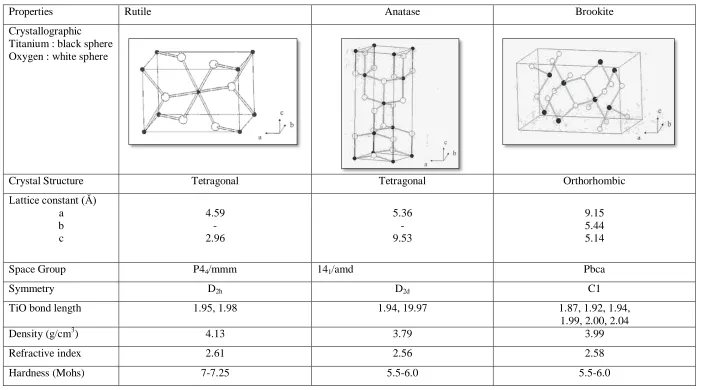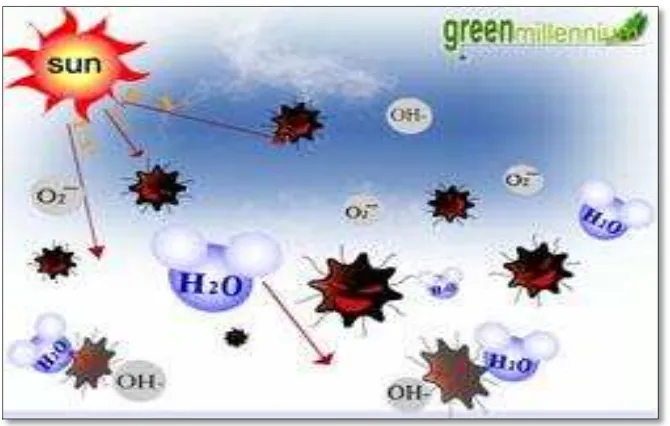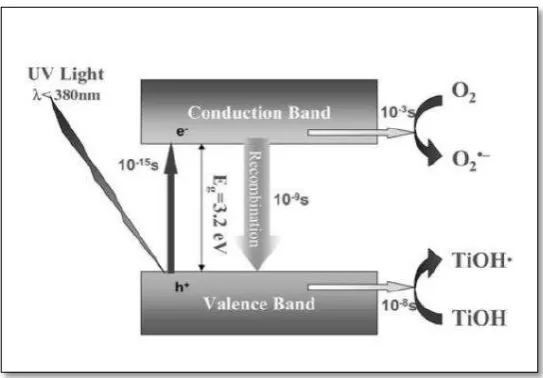UNIVERSITI TEKNIKAL MALAYSIA MELAKA
FABRICATION OF TITANIUM DIOXIDE (TiO
2) BY HIGH
TEMPERATURE OXIDATION OF PHYSICAL VAPOUR
DEPOSITION (PVD) TITANIUM FILM
This report submitted in accordance with requirement of the Universiti Teknikal Malaysia Melaka (UTeM) for the Bachelor Degree of Manufacturing Engineering
(Engineering Materials) (Hons.)
by
NOORFAIZOL BIN MOHAMAD NOOR
B050910100
860710355245
UNIVERSITI TEKNIKAL MALAYSIA MELAKA
BORANG PENGESAHAN STATUS LAPORAN PROJEK SARJANA MUDA
TAJUK: Farication of titanium dioxide (TiO2) by high temperature oxidation of physical
vapour deposition (PVD) titanium film.
SESI PENGAJIAN: 2012/13 Semester 2
Saya NOORFAIZOL BIN MOHAMAD NOOR
mengaku membenarkan Laporan PSM ini disimpan di Perpustakaan Universiti Teknikal Malaysia Melaka (UTeM) dengan syarat-syarat kegunaan seperti berikut:
1. Laporan PSM adalah hak milik Universiti Teknikal Malaysia Melaka dan penulis.
2. Perpustakaan Universiti Teknikal Malaysia Melaka dibenarkan membuat salinan
untuk tujuan pengajian sahaja dengan izin penulis.
3. Perpustakaan dibenarkan membuat salinan laporan PSM ini sebagai bahan
pertukaran antara institusi pengajian tinggi.
(Mengandungi maklumat TERHAD yang telah ditentukan oleh organisasi/badan di mana penyelidikan dijalankan)
Alamat Tetap:
** Jika Laporan PSM ini SULIT atau TERHAD, sila lampirkan surat daripada pihak berkuasa/organisasi berkenaan dengan menyatakan sekali sebab dan tempoh laporan PSM ini perlu dikelaskan sebagai SULIT atau TERHAD.
DECLARATION
I hereby, declared this report entitled “Fabrication of titanium dioxide (TiO2) by
high temperature oxidation of physical vapour deposition (PVD) titanium film” is the results of my own research except as cited in references.
Signature : ……….
Author’s Name : ………
Date : ………
APPROVAL
This report is submitted to the Faculty of Manufacturing Engineering of UTeM as a partial fulfillment of the requirements for the degree of Bachelor of Manufacturing Engineering (Engineering Materials) (Hons.). The members of the supervisory committee are as follow:
……… (Prof. Dr. Mohd Razali bin Mohamad)
i
ABSTRAK
Tujuan laporan ini adalah untuk mencadangkan satu kaedah baru untuk menghasilkan lapisan titanium dioksida (TiO2) nipis pada substrat kaca untuk
aplikasi cermin yang membersihkan secara sendiri. Terdapat beberapa kaedah yang digunakan untuk menghasilkan lapisan TiO2 nipis dan yang selalu menjadi pilihan
adalah melalui kaedah pemendapan wap fizikal (PVD) melalui pengeluaran atom reaktif. Oleh kerana terdapat beberapa kelemahan dalam kemasukan gas oxygen dengan menggunakan kaedah pengeluaran atom raeaktif PVD , kajian ini bertujuan untuk menyelidik teknik sintesis alternatif pembuatan lapisan nipis TiO2 melalui dua
ii
ABSTRACT
The purpose of this research is to develop a new synthesis method of titanium dioxide (TiO2) thin film coating on glass substrates for self-cleaning glasses
application. There are several method use to fabricate the TiO2 thin film but the most
favorable is via Physical Vapour Deposition (PVD) reactive sputtering. Due to the disadvantages in controlling the oxygen incorporation using PVD, the current work explores an alternative synthesis technique of TiO2 thin film which consisted of two
iii
DEDICATION
iv
ACKNOWLEDGEMENT
Bismillahirrahmanirrahim,
I would like to convey my gratitude to Allah S.W.T for giving me strength and willingness to be able to completed this final year project. I am indebted to many people during this research. I would like to express my special gratitude, appreciation and thanks to Dr Lau Kok Tee as my co-supervisor in this project where he teach a lot of knowledge that is new for me, helping me upon the completion of this research and assist me all the time. Not forgetting my principal supervisor Prof, Dr Razali bin Mohamad, technicians, Mr Sarman, Mr Azhar, Mr Hairulhisyam, Mr Bahatiar and all the technicians and friends that involved upon completing this project.
v
2.3.1 Magnetron Sputter Deposition 11
2.3.2 Advantages and disadvantages of sputter deposition technique 13
vi
3.2.1 Sputtering Process Description 19
3.3 High Temperature Oxidation of Ti Thin Film 20 3.3.1 High Temperature Oxidation Process Description 21
3.4 Microstructure Observation 23
3.5 Surface Morphology and Thickness Measurement 24
3.5.1 SEM Process Description 25
3.6 Characterization: Crystallography and Phase 26
3.6.1 XRD Process Description 26
3.7 Characterization: Band gap 27
3.7.1 UV-VIS Process Description 28
3.6.3 Characterization details 29
3.7 Band gap test 29
3.7.1 Testing 30
CHAPTER 4: RESULT AND DISCUSSION 29
4.1 Raw Result of Fabricated Samplea 29
4.1.1 Samples After Deposition 29
4.1.2 Samples After High Temperature Oxidation 30 4.2 Microstructure Observation by Optical Microscope 31 4.3 Microstructural and Thickness Observation by SEM 33 4.3.1 SEM Surface Microstructure Observation 33
4.3.2 EDX Scanning 35
4.3.3 Cross section image of sample oxidize at 400 °C 37
4.4 Phase Composition 38
4.5 Band Gap Result 40
4.5.1 Test result 40
vii
CHAPTER 5: CONCLUSION AND FUTURE WORKS 46
5.1 Conclusion 46
5.2 Future Works 47
REFERENCES
viii
LIST OF TABLES
2.1 Basic properties of TiO2 6
3.1 Process flow of Ti thin film fabrication 20 3.2 Observed samples in optical microscope 24 4.1
4.2 4.3 4.4
EDX scan
Calculated α1/2 and eV value of samples oxidize at 200 °C Calculated α1/2 and eV value of samples oxidize at 300 °C Calculated α1/2 and eV value of samples oxidize at 400 °C
ix
LIST OF FIGURES
2.1 Photocatalyctic action of TiO2 7
2.2
Band theory of mechanism of Photocatalysis PVD processing techniques
Ion bombardment of sputter deposition Ti-O Phase diagram
Project flowchart
Microscope glass slides and after being cut into sample a) Ultrasonic machine b) Cleaning setup
VACTEC Korea VTC PVD 1000 Sample after the titanium thin film fabrication Unmagnified image of oxidize samples Optical microscope image
SEM image of the surface morphology SEM image of EDX scan
EDX Spectra
Cross section image of sample oxidize at 400 ºC
Combined XRD pattern of sample oxidize at 200 ºC,300 ºC and 400 ºC
Plotted data of sample oxidize at 200 ºC Plotted data of sample oxidize at 300 ºC Plotted data of sample oxidize at 400 ºC
x
LIST OF ABBREVIATIONS, SYMBOLS AND
xi UHV - Ultra High Vacuum
UV - Ultra Violet
v - velocity
W - Watt
XRD - X-Ray Diffraction
HCP - Hexagonal Closed Packed
 - Angstrom
4
CHAPTER 1
INTRODUCTION
This chapter will introduce the background of the study as well as problem statement, objectives and scopes. The content of this chapter explained about why this research was carried out.
1.1 Background of Study
Nowadays the self-cleaning glasses are the common engineering materials used as for building, tower, car windshield etc. It is due to the ability to self-clean without the use of any human labour. The self-cleaning occurs naturally with the help of sun and rain. Imagine the labours that are hired to clean the windows of Kuala Lumpur Twin Tower (KLCC). These people need to be paid in huge amount of salary due to the dangerousness of their work. By using the self-cleaning glass, the danger and cost can be reduce to zero.
The magic behind the self-cleaning glasses is the titanium dioxide (TiO2) thin film
coating applied on the surface of the glass where TiO2 is a special compound
material that has photocatalyctic properties that can decompose any air borne toxic organic matter. The further discussion of this topic will be discussed in this report.
Aside from that, this report will also discuss the fabrication of the tin film coating of TiO2 that later will be used in this research. Physical vapour deposition (PVD) is one
5 its disadvantages, the fabrication method need to be altered. This report will propose and experiment on the TiO2 thin film coating fabrication method.
1.2 Problem Statement
Titanium Dioxide (TiO2) thin film coating can be fabricated by various methods and
techniques. The method are Physical Vapour Deposition (PVD), Chemical Vapour Deposition (CVD), sol-gel dip coating, spin coating, and spray pyrolysis. Among all these method, PVD and CVD are the common method to fabricate thin film coating. Whilst between these two common method, PVD is most favourable due to its advantages on operating on low temperature, finer coating grain size, smooth surface, low crack initiation and propagation on the coating (Campbell, 2008). Despite all the advantages, PVD has its own on disadvantages in controlling the oxidation rate for efficient oxidation coating (Heinrichs et al. 2008). In order to obtain stoichiometry of TiO2, several parameter need to be pre-determined before the
deposition. One of the parameter is the oxygen flux must be control efficiently. If the amount of oxygen is high, the growth rate of the thin film is slower and if the amount of oxygen is low, it will result in an incomplete oxidation. The nucleation growth of oxide layer causes agglomeration and amorphous TiO2. During deposition, the
sputtered atoms from the target tend to lost during transfer from target to substrates due to argon-oxygen mixtures that result in loss of TiO2 stoichiometry of the
deposited film materials (Donald, 1998). It is expected that by two steps method will create a decent stoichiometry of the TiO2 thin film layer. The two step method use in
this report is defined by thin film deposition and oxidation process are done separately where the titanium thin film is deposit using PVD machine and the oxidation process of the thin film takes place in the tube furnace (ex-situ). The term
ex-situ in this report is defined by oxidation process of titanium thin film takes place
6
1.3 Objective
The purpose of this research is to synthesize TiO2 thin film on glass substrates using
two steps method which is; (i) Deposition of titanium (Ti) film on glass substrate by DC magnetron sputtering, and (ii) High temperature oxidization of the TiO2 film in
tube furnace (ex situ ).Below are the specific objectives for this research;
i. To synthesize the titanium dioxide (TiO2) thin film using ex-situ oxidation of
DC magnetron sputtered titanium film.
ii. To study the microstructure, surface morphology and phase composition of the TiO2 film at different temperature.
iii. To determine the band gap of the fabricated TiO2 thin film.
1.3 Scope and limitation
The deposition of the Ti thin film were done using DC magnetron sputtering in a vacuum chamber with pressure of 5x10-3 mbar, chamber temperature setting, 300 °C, sputtering power, 3000 W and deposition time, 30 minutes. For the oxidation process, it will be conducted in controlled oxygen flow environment (oxygen partial pressure = 100%) the oxygen flow were set to 15 psi. The oxidation temperatures were made as the manipulated variable which is 200 °C, 300 °C and 400 °C. The temperature ramp rate were made constant at 1 °C/min as well as the cooling rate at -1 °C/min. Characterization of the TiO2 thin film were done by the optical
7
CHAPTER 2
LITERATURE REVIEW
This chapter will discuss further on the literature review that is related to the general info of titanium dioxide (TiO2). The later section will focus on the Tio2 material and
its general physical properties and crystallography. Next is the photocatalyst properties that are the main reason why TiO2 is being used as the thin film coating on
glass. The fabrication used in this research is physical vapour deposition (PVD). There are many types of PVD method. In this research, the PVD method use is DC magnetron sputtering.
2.1 Titanium Dioxide (TiO2)
Titanium dioxide (TiO2) has been commercialized since the early 20th century and it
is widely used as pigment, sunscreen, paint, ointment and etc (Xiabo, 2007). In 1972, Fujishima and Honda discovered the photocatalyst phenomenon where water is splitting on the TiO2 electrode under the ultraviolet light (UV). Since this discovery,
a lot of research has been done that led to new technology such as photovoltaic, photocatalysis, photochemical and sensors. All the discovery mention has fulfil the needs in energy and environment area. The TiO2 is very versatile material and it
depends not only on the properties itself but also on the modification of TiO2 host.
TiO2 exists in three phase that has different crystal structures and physical properties.
8
2.1.1 Basic Properties of Titanium Dioxide (TiO2)
Titanium Dioxide occurs naturally in three modification form which is rutile, anatase and brookite. Between these three, rutile, and anatase are the most common form. The crystallographic arrangements of this modification are titanium atom surrounded octahedrally by oxygen atom. Rutile has the hexagonal close packing of the oxygen atoms, in which half of the octahedral space filled with titanium. It has the highest refractive index and highest density compare with other TiO2 form. Anatase is a
cubic close packing of the oxygen atoms, in which half of the tetrahedral space filled with titanium. Anatase has the lowest refractive index and density. Among all the three form of TiO2, there is not much different in term of refractive index and density.
Lastly, Brookite has the orthorhombic crystal structure where the titanium atom at the centre surrounded by six oxygen atoms. Anatase and Brookite will transform into rutile at the temperature above 973°K where it is thermodynamically stable. Table 2.1 show the summarization of basic physical properties of the TiO2 of three
9 Table 2.1: Basic properties of TiO2 (Nakaruk, 2010)
Properties Rutile Anatase Brookite
Crystallographic Titanium : black sphere Oxygen : white sphere
Crystal Structure Tetragonal Tetragonal Orthorhombic
15
2.2 Photocatalysis of Titanium Dioxide (TiO2)
Photocatalysis is an action when a source of light that acts as the catalyst to activate a substance i.e TiO2 and create electron-hole pair result in formation of free radical
anion. The act radical anion, O2- and OH when activated by UV light and with help of water (H2O) allows the substrates to self-clean. The substrates of TiO2 is use to
eliminate harmful substances attached on the substrates such as organic compounds or nearby bacteria when it is exposed to the sun or fluorescent lamp. A figure 2.1 describes the general concept of photocatalytic action of TiO2.
Figure 2.1: Photocatalyctic action of TiO2 (Green Millenium, 2013)
Photocatalysts of TiO2 were found out to be effective as purifying agent. For
examples, if catalytically active TiO2 powder put in a contaminated pool and allowed
it to be illuminated with sunlight, the water will gradually become purified (Fujishima et al. 2000). In details, their function of the can be divided into five major categories as follows; i) Purifying water, ii) Preventing contamination, iii) Anti bacteria, iv) Deodorizing, and v)Purifying air.
The mechanism of the TiO2 thin film photocatalyst is when the adsorbed light is
16 jump into the conduction band due to TiO2 semiconducting properties. This will
leave hole in the valence band and create vacancy. Nakaruk (2010) stated that based on the occurrence, these photon-generated electron-hole pair can either recombine or take part in redox (reduction of oxygen). The majority of the electron will recombine with dissipation of heat while some of them migrate to the surface and will react with adsorbed electron donor. Shown below is the calculation of light wavelength:
*Therefore, the light wavelength that need to activate TiO2 photocatalyst is 388 nm.
When TiO2 thin film exposed to the light source that has a UV light, it will generate
17 Figure 2.2: Band theory of mechanism of Photocatalysis (Nakaruk, 2010)
2.3 Physical Vapour Deposition (PVD)
PVD is a process where coating material in form of solid or liquid in are vaporized and transferred in vacuum chamber or low pressure gaseous environment it onto the desired substrate (deposition). PVD is one of the methods of surface coating technique used to change the surface or near surface to desired criteria. Generally this process also called surface coating. PVD coating thickness is in range of few nanometres to a thousand of nanometres (thin film). Besides that, it is also used to synthesize multilayer coatings, graded composition deposits, very thick deposits and freestanding structures. PVD can coat a substrate in many sizes from large to small and various shapes from flat to complex geometry. Typical PVD deposition rates are 10–100Å (1–10 nanometres) per second (Donald, 1998)


